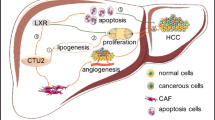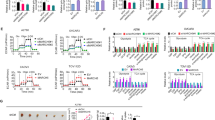Abstract
Glyoxalase 1 (Glo1), belonging to the glyoxalase system, participates in the detoxification of methylglyoxal (MG), a byproduct of glycolysis. Glo1 is associated with the progression of many human malignancies. However, the role of Glo1 in hepatocellular carcinoma (HCC) is unclear. We have discovered that the expression of Glo1 is up-regulated in HCC tissues compared with adjacent non-tumorous tissues, and knockdown of Glo1 expression by RNA interference significantly inhibited the proliferation of human HCC cell lines. Glo1 knockdown resulted in the accumulation of its cytotoxic substrate, MG. Overall, thus Glo1 might be essential for HCC progression and can be designated as a potential therapeutic target for HCC in the future.




Similar content being viewed by others
References
Aravalli RN, Steer CJ, Cressman ENK (2008) Molecular mechanisms of hepatocellular carcinoma. Hepatology 48:2047–2063
Cheng W-L, Tsai M-M, Tsai C-Y, Huang Y-H, Chen C-Y, Chi H-C, Tseng Y-H, Chao I-W, Lin W-C, Wu S-M, Liang Y, Liao C-J, Lin Y-H, Chung IH, Chen W-J, Lin PY, Wang C-S, Lin K-H (2012) Glyoxalase-I is a novel prognosis factor associated with gastric cancer progression. PLoS One 7:e34352
El-Serag HB, Rudolph L (2007) Hepatocellular carcinoma: epidemiology and molecular carcinogenesis. Gastroenterology 132:2557–2576
Ganapathy-Kanniappan S, Kunjithapatham R, Geschwind J-F (2012) Glyceraldehyde-3-phosphate dehydrogenase: a promising target for molecular therapy in hepatocellular carcinoma. Oncotarget 3:940–953
Kalapos MP (2008) The tandem of free radicals and methylglyoxal. Chem Biol Interact 171:251–271
Liu Y, Zhu X, Zhu J, Liao S, Tang Q, Liu K, Guan X, Zhang J, Feng Z (2007) Identification of differential expression of genes in hepatocellular carcinoma by suppression subtractive hybridization combined cDNA microarray. Oncol Rep 18:943–951
Livak KJ, Schmittgen TD (2001) Analysis of relative gene expression data using real-time quantitative PCR and the 2(T)(-Delta Delta C) method. Methods 25:402–408
McLellan AC, Phillips SA, Thornalley PJ (1992) The assay of methylglyoxal in biological-systems by derivatization with 1,2-diamino-4,5-dimethoxybenzene. Anal Biochem 206:17–23
Nemet I, Varga-Defterdarovic L, Turk Z (2004) Preparation and quantification of methylglyoxal in human plasma using reverse-phase high-performance liquid chromatography. Clin Biochem 37:875–881
Santarius T, Bignell GR, Greenman CD, Widaa S, Chen L, Mahoney CL, Butler A, Edkins S, Waris S, Thornalley PJ, Futreal PA, Stratton MR (2010) GLO1-A novel amplified gene in human cancer. Genes Chromosom Cancer 49:711–725
Sharkey EM, O’Neill HB, Kavarana MJ, Wang HB, Creighton DJ, Sentz DL, Eiseman JL (2000) Pharmacokinetics and antitumor properties in tumor-bearing mice of an enediol analogue inhibitor of glyoxalase I. Cancer Chemother Pharmacol 46:156–166
Thornalley PJ (1993) The glyoxalase system in health and disease. Mol Aspects Med 14:287–371
Thornalley PJ, Rabbani N (2011) Glyoxalase in tumourigenesis and multidrug resistance. Semin Cell Dev Biol 22:318–325
Wang Y, Kuramitsu Y, Ueno T, Suzuki N, Yoshino S, Iizuka N, Akada J, Kitagawa T, Oka M, Nakamura K (2012) Glyoxalase I (GLO1) is up-regulated in pancreatic cancerous tissues compared with related non-cancerous tissues. Anticancer Res 32:3219–3222
Warburg O (1923) Tests on surviving carcinoma cultures. Biochem Z 142:317–333
Acknowledgments
We thank Dr. Shoudong Ye for his critical reading of the manuscript. This work was supported by the National Key Sci-Tech Special Project of China (2013ZX10002010).
Author information
Authors and Affiliations
Corresponding author
Electronic supplementary material
Below is the link to the electronic supplementary material.
Fig. S1
The effect of Glo1 overexpression on cell proliferation. The proliferation assays were performed in three HCC cell lines: Hep3B (a), SK-HEP-1 (b) and SMMC-7721 (c). Data represent the mean ± SD, n = 5 (TIFF 809 kb)
Fig. S2
The cytotoxic effect of MG on HCC cell lines. MG toxicity assays were performed in three HCC cell lines: Hep3B (a), SK-HEP-1 (b) and SMMC-7721 (c). During a 6-day culture period, the culture mediums were changed everyday with indicated concentrations of MG. Data represent the mean ± SD, n = 5 (TIFF 526 kb)
Rights and permissions
About this article
Cite this article
Hu, X., Yang, X., He, Q. et al. Glyoxalase 1 is up-regulated in hepatocellular carcinoma and is essential for HCC cell proliferation. Biotechnol Lett 36, 257–263 (2014). https://doi.org/10.1007/s10529-013-1372-6
Received:
Accepted:
Published:
Issue Date:
DOI: https://doi.org/10.1007/s10529-013-1372-6




